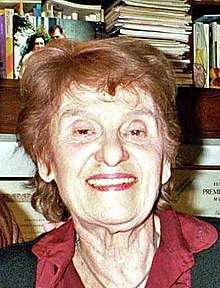Violeta Hemsy de Gainza
Violeta Hemsy de Gainza (born 25 January 1929) is an Argentine pianist and piano pedagogue.
Violeta Hemsy de Gainza | |
|---|---|
 | |
| Born | 25 January 1929 Tucumán Province, Argentina |
| Education | |
| Occupation | Pianist, pedagogue |
| Awards | Konex Award (1989) |
| Website | www |
Biography
Violeta Hemsy de Gainza was born in Tucumán Province on 25 January 1929.[1] She completed her undergraduate studies at the National University of Tucumán, where she graduated with a licentiate in music, piano specialty. In 1951 she obtained a scholarship to improve her skills at the Teacher's College at Columbia University in New York. She later studied in Paris with Gerda Alexander, creator of the concept of "eutony" (1976), and in Denmark (1982). She has written about 40 publications that have been translated into English, French, German, Italian, Portuguese, and Dutch, ranging from general music pedagogy, piano, and guitar teaching, to children's and youth vocal ensembles, as well as improvisation and music therapy. These are frequently cited in theses and research papers.[2][3]
She served as president of the Latin American Forum of Musical Education (FLADEM) from its founding in 1995 until 2005.[4] She was a board member of the International Society for Music Education (ISME) from 1986 to 1990. She has also been invited as a juror, teacher, and lecturer by universities, conservatories, musical and artistic centers, as well as international organizations such as the Organization of American States, UNESCO, and governments such as France, Germany, Spain's Ministry of Education, and Colombia's Ministry of Culture.[5][6]
In 1989, Hemsy received the Konex Award diploma of merit for classical music.[1]
She also ventured into the publishing field as director of the Pedagogical Library Musical Collection for the Guadalupe Publishing House, editor of the ISME yearbooks in Spanish, editor of the magazine of the Argentine Association of Music Therapy, and co-director of the Lumen Publishing Group's Body, Art, and Health Collection.[7]
Hemsy has served as ISME's honorary president and coordinator of its Music Therapy Commission (1974–1986), and has taught at the Carlos López Buchardo National Conservatory and the Manuel de Falla Municipal Conservatory in Buenos Aires.[8]
Her students include prominent musicians such as Andrés Calamaro, Claudio Gabis, Fito Páez, Ariel Rot, and Leo Sujatovich.[9][10]
Selected works
- Fundamentos, materiales y técnicas de la educación musical (1984), Editorial Ricordi Americana, ISBN 9789502202167.
- La iniciación musical del niño (1984), Editorial Ricordi Americana, ISBN 9789502202037.
- Método para piano (1984), Editorial Barry, ISBN 9789505400003.
- Música para niños compuesta por niños (1984), Editorial Guadalupe, ISBN 9789505000661.
- A jugar y cantar con el piano (1993), Editorial Guadalupe, ISBN 9789505001842.
- La educación musical frente al futuro (1993), Editorial Guadalupe, ISBN 9789505003037.
- La improvisación musical (1993), Editorial Ricordi Americana, ISBN 9789502202662.
- El cantar tiene sentido (1994), Editorial Ricordi Americana, ISBN 9789502202679.
- Aproximación a la eutonía, conversaciones con Gerda Alexander (1997), Editorial Paidós, ISBN 9789501244205.
- Claudio Gabis: sur, blues y educación musical (2000), Editorial Lumen, ISBN 9789870000242.
- En música in dependencia educación y crisis social (2007), Editorial Lumen, ISBN 9789870006893.
- Conversaciones con Gerda Alexander (2007), Editorial Lumen, ISBN 9789870006817.
References
- "Violeta Hemsy de Gainza" (in Spanish). Konex Foundation. Retrieved 5 December 2019.
- Casal de la Fuente, Lucía (2016). "A experiência musical na instrução e educação musical e na musicoterapia" [The Musical Experience in Musical Education and in Music Therapy] (in Portuguese). Federal University of Rio Grande do Sul. Retrieved 5 December 2019 – via USC Minerva.
- Soares dos Santos, Hermes; Ferreira da Silva Teixeira, Célia Maria; Zanini, Claudia Regina de Oliveira (2011). "Contribuições da musicoterapia para o fortalecimento da subjetividade de adolescentes participantes de um projeto social" [Contributions of Music Therapy to the Strengthening of the Subjectivity of Adolescents Participating in a Social Project]. Opus (in Portuguese). Associação Nacional de Pesquisa e Pós-graduação em Música. 17 (2). ISSN 1517-7017. Retrieved 5 December 2019.
- "Boletín Extraordinario" (in Spanish). FLADEM. May 2000. Archived from the original on 15 June 2008. Retrieved 5 December 2019.
- "La argentina Violeta Hemsy ofrecerá una masterclass en Lucena" [The Argentine Violeta Hemsy to Offer a Master Class in Lucena]. Córdoba (in Spanish). 27 February 2008. Retrieved 5 December 2019.
- Congreso Iberoamericano de Cultura [Ibero-American Congress of Culture] (in Spanish). Ministry of Culture of Colombia. 2010. p. 26. Retrieved 5 December 2019 – via issuu.
- "Por los pasillos" [Through the Halls]. La Gaceta (in Spanish). 8 May 2008. Retrieved 5 December 2019.
- "Velada de voces y piano" [Evening of Voices and Piano]. El Litoral (in Spanish). 27 September 2016. Retrieved 5 December 2019.
- "Abierto hasta las 2 – Acústico Ariel Rot – Primera hora" (in Spanish). RTVE. 20 June 2010. Retrieved 5 December 2019.
- Calderón, Verónica (9 June 2011). "'Aprender música es un derecho humano'" [Learning Music is a Human Right]. El País (in Spanish). Retrieved 5 December 2019.
External links
- Official website

- Violeta Hemsy de Gainza at ISME